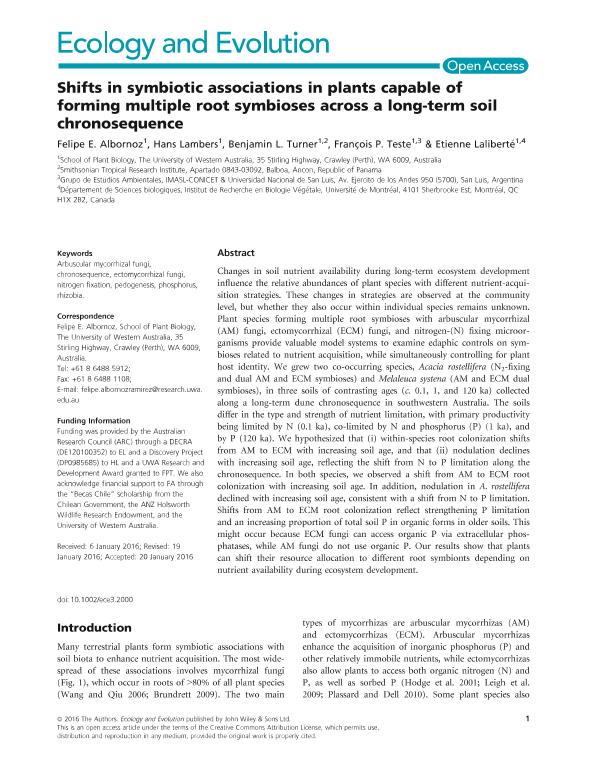Mostrar el registro sencillo del ítem
dc.contributor.author
Albornoz, Felipe E.
dc.contributor.author
Lambers, Hans
dc.contributor.author
Turner, Benjamin L.
dc.contributor.author
Teste, Francois

dc.contributor.author
Laliberté, Etienne
dc.date.available
2018-09-21T15:57:24Z
dc.date.issued
2016-04
dc.identifier.citation
Albornoz, Felipe E.; Lambers, Hans; Turner, Benjamin L.; Teste, Francois; Laliberté, Etienne; Shifts in symbiotic associations in plants capable of forming multiple root symbioses across a long-term soil chronosequence; John Wiley & Sons Ltd; Ecology and Evolution; 6; 8; 4-2016; 2368-2377
dc.identifier.issn
2045-7758
dc.identifier.uri
http://hdl.handle.net/11336/60567
dc.description.abstract
Changes in soil nutrient availability during long-term ecosystem development influence the relative abundances of plant species with different nutrient-acquisition strategies. These changes in strategies are observed at the community level, but whether they also occur within individual species remains unknown. Plant species forming multiple root symbioses with arbuscular mycorrhizal (AM) fungi, ectomycorrhizal (ECM) fungi, and nitrogen-(N) fixing microorganisms provide valuable model systems to examine edaphic controls on symbioses related to nutrient acquisition, while simultaneously controlling for plant host identity. We grew two co-occurring species, Acacia rostellifera (N2-fixing and dual AM and ECM symbioses) and Melaleuca systena (AM and ECM dual symbioses), in three soils of contrasting ages (c. 0.1, 1, and 120 ka) collected along a long-term dune chronosequence in southwestern Australia. The soils differ in the type and strength of nutrient limitation, with primary productivity being limited by N (0.1 ka), co-limited by N and phosphorus (P) (1 ka), and by P (120 ka). We hypothesized that (i) within-species root colonization shifts from AM to ECM with increasing soil age, and that (ii) nodulation declines with increasing soil age, reflecting the shift from N to P limitation along the chronosequence. In both species, we observed a shift from AM to ECM root colonization with increasing soil age. In addition, nodulation in A. rostellifera declined with increasing soil age, consistent with a shift from N to P limitation. Shifts from AM to ECM root colonization reflect strengthening P limitation and an increasing proportion of total soil P in organic forms in older soils. This might occur because ECM fungi can access organic P via extracellular phosphatases, while AM fungi do not use organic P. Our results show that plants can shift their resource allocation to different root symbionts depending on nutrient availability during ecosystem development. Changes in soil nutrient availability during long-term ecosystem development influence the relative abundances of plant species with different nutrient-acquisition strategies. We grew two co-occurring mycorrhizal plant species in three soils of contrasting ages (c. 0.1, 1, and 120 ka). In both species, we observed a shift from AM to ECM root colonization with increasing soil age, consistent with a shift from N to P limitation. Here, we show that plants shift their resource allocation to different root symbionts depending on nutrient availability during ecosystem development.
dc.format
application/pdf
dc.language.iso
eng
dc.publisher
John Wiley & Sons Ltd

dc.rights
info:eu-repo/semantics/openAccess
dc.rights.uri
https://creativecommons.org/licenses/by/2.5/ar/
dc.subject
Arbuscular Mycorrhizal Fungi
dc.subject
Chronosequence
dc.subject
Ectomycorrhizal Fungi
dc.subject
Nitrogen Fixation
dc.subject
Pedogenesis
dc.subject
Phosphorus
dc.subject
Rhizobia
dc.subject.classification
Otras Ciencias Biológicas

dc.subject.classification
Ciencias Biológicas

dc.subject.classification
CIENCIAS NATURALES Y EXACTAS

dc.title
Shifts in symbiotic associations in plants capable of forming multiple root symbioses across a long-term soil chronosequence
dc.type
info:eu-repo/semantics/article
dc.type
info:ar-repo/semantics/artículo
dc.type
info:eu-repo/semantics/publishedVersion
dc.date.updated
2018-09-20T13:11:39Z
dc.journal.volume
6
dc.journal.number
8
dc.journal.pagination
2368-2377
dc.journal.pais
Reino Unido

dc.journal.ciudad
Londres
dc.description.fil
Fil: Albornoz, Felipe E.. University of Western Australia; Australia
dc.description.fil
Fil: Lambers, Hans. University of Western Australia; Australia
dc.description.fil
Fil: Turner, Benjamin L.. Smithsonian Tropical Research Institute; Panamá
dc.description.fil
Fil: Teste, Francois. Consejo Nacional de Investigaciones Científicas y Técnicas. Centro Científico Tecnológico Conicet - San Luis. Instituto de Matemática Aplicada de San Luis "Prof. Ezio Marchi". Universidad Nacional de San Luis. Facultad de Ciencias Físico, Matemáticas y Naturales. Instituto de Matemática Aplicada de San Luis "Prof. Ezio Marchi"; Argentina
dc.description.fil
Fil: Laliberté, Etienne. University of Montreal; Canadá
dc.journal.title
Ecology and Evolution
dc.relation.alternativeid
info:eu-repo/semantics/altIdentifier/doi/http://dx.doi.org/10.1002/ece3.2000
dc.relation.alternativeid
info:eu-repo/semantics/altIdentifier/url/https://onlinelibrary.wiley.com/doi/abs/10.1002/ece3.2000
Archivos asociados
